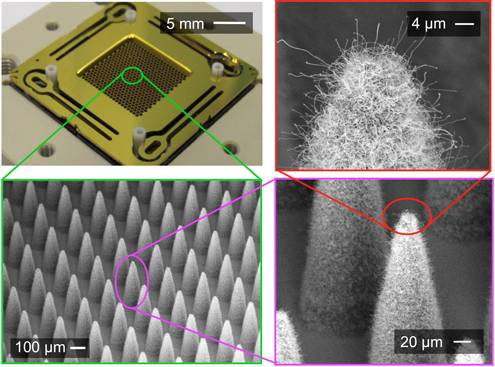
This is actually considered a small-scaled mass spectrometer. MIT researchers hope they make mass spectrometers that are small enough to hold in your hand. Making these sort of devices portable could have important consequences for field work. Photo: Medical College of Wisconsin
Since it was first introduced decades ago, mass spectrometry has proved to be an invaluable tool for analyzing the chemical makeup of foods, pharmaceuticals, forensic remains and so on. The equipment, however, is extremely bulky, expensive (in the hundreds of thousands range) and a sample might take days of back and forth analysis before results can be returned. MIT researchers report great leaps forward that might finally allow them to develop a new kind of spectrometry tech: small enough to fit in your hand, cheap and fast. For lab technicians around the world this might sound like a dream come true.
“The opportunity in mass spectrometers is to bring the analytical power of brick and mortar laboratories into the field,” says MIT’s Microsystems Technology Laboratories (MTL) Principal Research Scientist Luis Velásquez-García. “We think we could make something the size of a smartphone that does the same analyses as much larger systems without sacrificing performance, and at a fraction of the cost. This will allow us to put mass spectrometry in many places where it can’t be done now.”
Analyzing chemical makeup on the fly
When a sample is introduced in a mass spectrometer it first is vaporized (if it’s not already a gas), then ionized. The ions accelerate through the mass analyzer under the influence of electromagnetic forces. Eventually, the ions are separated by their mass-to-charge rations, which allows the machine to render results like what chemicals the sample is made of.
To make their handheld spectrometer, the MIT researchers engineered nanoscale spectrometry components like those required for ionizing sources for liquids and gases, a “quadrupole” that sorts out the chemical compounds, and a chip-scale vacuum pump. Also, the researchers thought ahead and also developed manufacturing methods and technology that will allow such handheld chemical analyzer to be mass produced.
The mini gas ionizer can work at vacuum pressures that are orders of magnitude higher than today’s commercial systems. This means that ion production becomes more efficient, while minimizing requirements for vacuum pumping.
The quadrupole, made out of four parallel rods that generate an oscillating electrical current, was demonstrated to sort out the sample’s chemical constituents with performance similar to that of the state-of-the-art systems.
Finally, the last important component, a chip-scale three-stage vacuum pump, was made with a minimum number of moving parts, effectively allowing the device to smaller than ever before.
“If you make systems smaller they probably consume less power, operate with smaller voltages, and can have higher throughput through multiplexing,” says Velásquez-García. “Miniaturization also can make the system less needy of special conditions — in this case, because these mass spectrometer components require substantially less of a vacuum than current systems, the system will consume a lot less energy and be a lot more portable.”
All of these components were designed to be manufactured in batches using current manufacturing technology. This means that the resulting spectrometer can be made fast and cheap. A lot cheaper actually, moving the price of a spectrometer to the range of a couple hundred dollars instead of over one hundreds thousand like we see today, according to the researchers.
With this kind of pricing, there’s really no limit to the range of applications mass spectrometers could be used. They could become ubiquitous in offices and streets, where they’d be used to analyze air quality and watch for harmful chemicals or emissions. A number of entrepreneurs see an opportunity to integrate downsized mass spectrometry with other business equipment, such as wireless routers or small cell base stations, to analyze office air quality.










